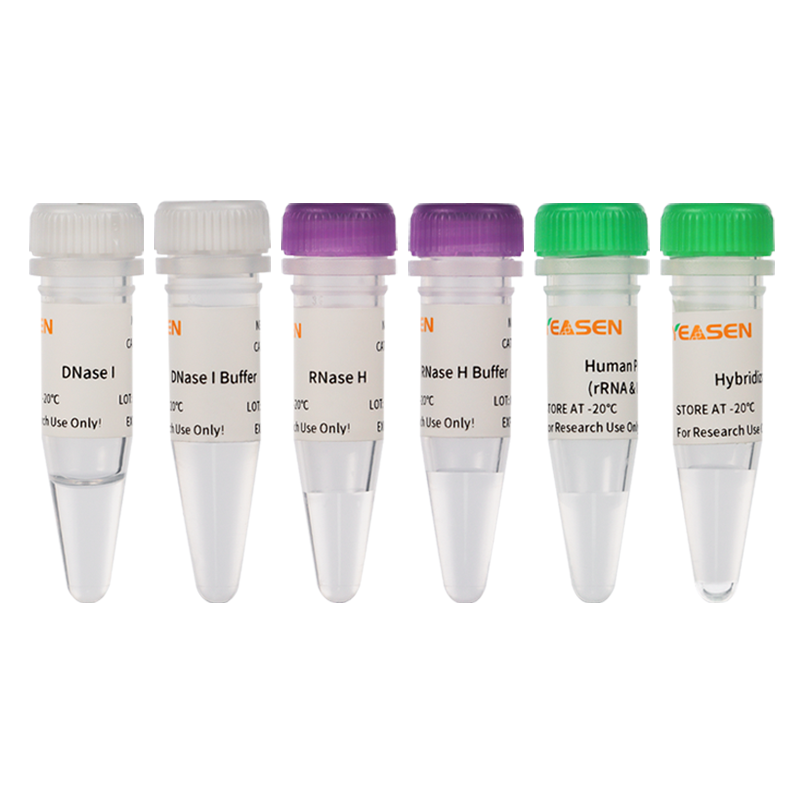Description
Hieff NGS™ MaxUp Human rRNA Depletion Kit (rRNA & ITS/ETS) is designed to remove rRNA and 45S ITS/ETS from human, mouse and rat total RNA based on RNase H-based workflow and to retain mRNA and other non-coding RNA. This kit is suitable for both intact and partially degraded RNA samples (e.g., FFPE RNA). Since degraded FFPE samples usually contain a higher proportion of ITS/ETS than fresh tissue samples, this kit adds probes in the Human 45S ITS/ETS region, and ITS removal can significantly increase the proportion of valid data in raw data.
Features
- Strong specificity: specifically remove rRNA and ITS/ETS from human samples, especially for FFPE samples
- High compatibility of template starting amount: applicable to 100 ng~1μg sample
- High removal effect: for rRNA, ITS and ETS in human\mouse and rat samples, the removal effect is more than 95%
- Stable quality: strict batch performance and stability quality control
Applications
- Gene Expression Research
- Alternative splicing analysis
- Detection and discovery of non coding RNA
- dentification of selective polyadenylation sites
- Fusion gene detection
Specifications
| Depletion Technology | RNase H |
| Sample Type | Total RNA of human, mouse and rat |
| Final Product Type | mRNA and other non coding RNAs |
| No. of Reactions | 24/96 Preps |
| Starting Material Amount | 100 ng~1 μg total RNA |
| Target | Remove rRNA and 45S ITS/ETS form human total RNA |
Components
| Components No. | Name | 12257ES24 (24T) | 12257ES96 (96T) |
| 12257-A | Hybridization Buffer | 72 μL | 288 μL |
| 12257-B | Probe Mix (rRNA & ITS/ETS) | 48 μL | 192 μL |
| 12257-C | RNase H Buffer | 72 μL | 288 μL |
| 12257-D | RNase H | 48 μL | 192 μL |
| 12257-E | DNase I Buffer | 660 μL | 2×1320 μL |
| 12257-F | DNase I | 60 μL | 240 μL |
Shipping and Storage
All the components are shipped with dry ice and can be stored at -15℃ ~ -25℃ for one year.
Figures
- rRNA removal specificity
For conventional samples, rRNA and ITS/EST can be removed by more than 98%, while for FFPE samples with integrity of about 50%, rRNA and ITS/EST can be removed by more than 95%. At the same time, FFPE with poor integrity can also be removed effectively.
Table 1. rRNA Removal specificity effect
| RNA quality | Removal scheme | Input | rRNA (%) | ITS/ETS (%) | Mapping (%) |
| 293T RNA; RIN=10 | remove rRNA | 1μg | 0.19 | 4.6 | 98.28 |
| remove rRNA and ITS/ETS | 1μg | 0.15 | 0.04 | 98.79 | |
| FFPE RNA; DV200 =90% | remove rRNA | 500ng | 0.23 | 4.75 | 95.35 |
| remove rRNA and ITS/ETS | 500ng | 0.21 | 0.02 | 95.42 | |
| FFPE RNA; DV200 =50% | remove rRNA | 500ng | 1.4 | 16.28 | 95.57 |
| remove rRNA and ITS/ETS | 500ng | 0.56 | 0.11 | 95.51 | |
| FFPE RNA; DV200 =20% | remove rRNA | 1μg | 0.35 | 67.61 | 58.4 |
| remove rRNA and ITS/ETS | 1μg | 0.79 | 0.84 | 60.35 |
Note: Different human RNA samples were used to remove rRNA or rRNA and ITS/ETS, and to construct libraries with RNA library Prep kit after ITS/ETS. The proportions of rRNA and ITS/ETS in offline data were analyzed by sequencing.
- Sequencing data performance
Table 2. Sequencing data performance
| Sample | DV200 | Kit | Clean Q20 (%) | Clean Q30 (%) | Clean GC (%) | rRNA (%) | ITS/ETS (%) | unique(%) |
| 1 | 24% | YEASEN Cat#12257 | 96.75 | 92.68 | 57.05 | 4.58 | 2.42 | 96.90 |
| 2 | 40% | 96.56 | 92.42 | 55.31 | 1.93 | 0.63 | 96.45 | |
| 3 | 53% | 97.4 | 93.52 | 45.19 | 0.23 | 0.01 | 98.08 | |
| 4 | 76% | 97.67 | 93.78 | 51.28 | 0.44 | 0.01 | 93.63 |
[1] Tian S, Zhang B, He Y, et al. CRISPR-iPAS: a novel dCAS13-based method for alternative polyadenylation interference. Nucleic Acids Res. 2022;50(5):e26. doi:10.1093/nar/gkac108(IF:16.971)
Payment & Security
Your payment information is processed securely. We do not store credit card details nor have access to your credit card information.
Inquiry
You may also like
FAQ
The product is for research purposes only and is not intended for therapeutic or diagnostic use in humans or animals. Products and content are protected by patents, trademarks, and copyrights owned by Yeasen Biotechnology. Trademark symbols indicate the country of origin, not necessarily registration in all regions.
Certain applications may require additional third-party intellectual property rights.
Yeasen is dedicated to ethical science, believing our research should address critical questions while ensuring safety and ethical standards.

